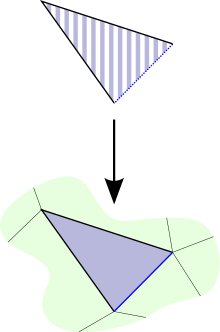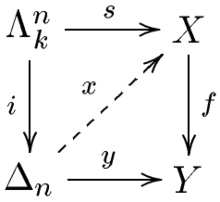Kan fibration
In mathematics, Kan complexes and Kan fibrations are part of the theory of simplicial sets. Kan fibrations are the fibrations of the standard model category for simplicial sets and are therefore of fundamental importance. Kan complexes are the fibrant objects in this model category. The name is in honor of Daniel Kan.
Definition

For each n ≥ 0, recall that the standard -simplex, , is the representable simplicial set
Applying the geometric realization functor to this simplicial set gives a space homeomorphic to the topological standard -simplex: the convex subspace of ℝn+1 consisting of all points such that the coordinates are non-negative and sum to 1.
For each k ≤ n, this has a subcomplex , the k-th horn inside , corresponding to the boundary of the n-simplex, with the k-th face removed. This may be formally defined in various ways, as for instance the union of the images of the n maps corresponding to all the other faces of .[1] Horns of the form sitting inside look like the black V at the top of the adjacent image. If is a simplicial set, then maps
correspond to collections of -simplices satisfying a compatibility condition. Explicitly, this condition can be written as follows. Write the -simplices as a list and require that
- for all with .[2]
These conditions are satisfied for the -simplices of sitting inside .

A map of simplicial sets is a Kan fibration if, for any and , and for any maps and such that (where is the inclusion of in ), there exists a map such that and . Stated this way, the definition is very similar to that of fibrations in topology (see also homotopy lifting property), whence the name "fibration".
Using the correspondence between -simplices of a simplicial set and morphisms (a consequence of the Yoneda lemma), this definition can be written in terms of simplices. The image of the map can be thought of as a horn as described above. Asking that factors through corresponds to requiring that there is an -simplex in whose faces make up the horn from (together with one other face). Then the required map corresponds to a simplex in whose faces include the horn from . The diagram to the right is an example in two dimensions. Since the black V in the lower diagram is filled in by the blue -simplex, if the black V above maps down to it then the striped blue -simplex has to exist, along with the dotted blue -simplex, mapping down in the obvious way.[3]
A simplicial set X is called a Kan complex if the map from X to 1, the one-point simplicial set, is a Kan fibration. In the model category for simplicial sets, is the terminal object and so a Kan complex is exactly the same as a fibrant object.
Examples
An important example comes from the singular simplices used to define singular homology. Given a space , define a singular -simplex of X to be a continuous map from the standard topological -simplex (as described above) to ,
Taking the set of these maps for all non-negative gives a graded set,
- .
To make this into a simplicial set, define face maps by
and degeneracy maps by
- .
Since the union of any faces of is a strong deformation retract of , any continuous function defined on these faces can be extended to , which shows that is a Kan complex.[4]
It can be shown that the simplicial set underlying a simplicial group is always fibrant.
Another important source of examples are the simplicial sets associated to a small groupoid . This is defined as the geometric realization of the simplicial set and is typically denoted . We could have also replaced with an infinity groupoid. It is conjectured that the homotopy category of geometric realizations of infinity groupoids is equivalent to the homotopy category of homotopy types. This is called the homotopy hypothesis.
Applications
The homotopy groups of a fibrant simplicial set may be defined combinatorially, using horns, in a way that agrees with the homotopy groups of the topological space which realizes it.
See also
- Weak Kan complex (also called quasi-category, ∞-category)
- ∞-groupoid
References
- See Goerss and Jardine, page 7
- See May, page 2
- May uses this simplicial definition; see page 25
- See May, page 3
Bibliography
Goerss, Paul G.; Jardine, John F. (1999). Simplicial Homotopy Theory. Basel: Birkhäuser Basel. doi:10.1007/978-3-0348-8707-6. ISBN 978-3-0348-9737-2. MR 1711612.
- May, J. Peter (1992) [1967]. Simplicial objects in algebraic topology. Chicago Lectures in Mathematics. Chicago, IL: University of Chicago Press. ISBN 0-226-51180-4. MR 1206474.